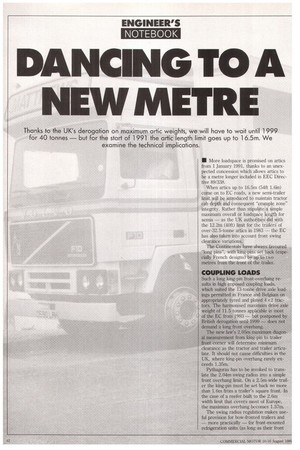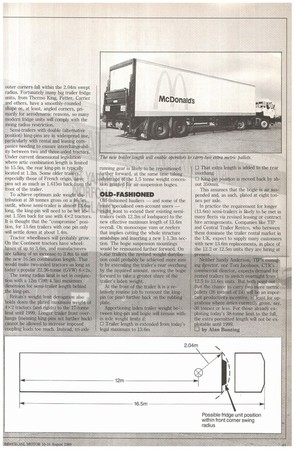DANCING TO A NEW METR
Page 44

Page 45

If you've noticed an error in this article please click here to report it so we can fix it.
• More loadspace is promised on attics from 1 January 1991, thanks to an unexpected concession which allows attics to be a metre longer included in EEC Directive 89/338.
When attics up to 16.5m (541t 1.6in) come on to EC roads, a new semi-trailer limit will be introduced to maintain tractor cab depth and consequent "crumple zone" integrity. Rather than stipulate a simple maximum overall or loadspace length for semis — as the UK authorities did with the 12.2m (40ft) limit for the trailers of over-32.5-tonne attics in 1983 — the EC has also taken into account front swing clearance variations.
The Continentals have always favoured "long pins", with king-gins set back (especially French designs) by up to two metres from the front of the trailer.
COUPLING LOADS
Such a long king-pin front-overhang results in high imposed coupling loads, which suited the 13-tonne drive axle loadings permitted in France and Belgium on appropriately tyred and plated 21x2 tractors. The harmonised maximum drive axle weight of 11.5 tonnes applicable in most of the EC from 1993 — but postponed by British derogation until 1999 -does not demand a long front overhang.
The new law's 2.05m maximum diagonal measurement from king-pm to trailer front corner will determine minimum clearance as the tractor and trailer articulate. It should not cause difficulties in the UK, where king-pin overhang rarely exceeds 1.35m.
Pythagoras has to be invoked to translate the 2.04m swing radius into a simple front overhang limit. On a 2.5m-wide trailer the king-pin must be set back no more than 1.6m from a trailer's square front. In the case of a reefer built to the 2.6m width limit that covers most of Europe, the maximum overhang becomes 1.57m.
The swing radius regulation makes useful provision for bow-fronted trailers and — more practically — for front-mounted refrigeration units (as long as their front outer corners fall within the 2.04m swept radius. Fortunately many big trailer fridge units, from Thermo King, Petter, Carrier and others, have a smoothly-rounded shape or, at least, angled corners, primarily for aerodynamic reasons, so many modern fridge units will comply with the swing radius restriction.
Semi-trailers with double (alternative position) king-pins are in widespread use, particularly with rental and leasing companies needing to ensure interchangeability between two and three-axled tractors. Under current dimensional legislation where artic combination length is limited to 15.5m, the rear king-pin is typically located at 1.2m. Some older trailers, especially those of French origin, have pins set as much as 1.615m back from the front of the trailer.
To achieve optimum axle weight distribution at 38 tonnes gross on a 16.5m outfit, whose semi-trailer is almost 13.6in long, the king-pin will need to be set about 1.55m back for use with 4x2 tractors. It is thought that the "compromise" position, for 13.6m trailers with one pin only will settle down at about 1.4m.
Tractor wheelbases will probably grow. On the Continent tractors have wheelbases of up to 3.6m, and manufacturers are talking of an increase to 3.8m to suit the new 16.5m combination length. That would make two-axled tractors as long as today's popular 22.36-tonne (GVW) 6 x 2s.
The swing radius limit is set in conjunction with a 12in (39ft 4. Sin) maximum dimension for semi-trailer length behind the king-pin.
Britain's weight limit derogation also holds down the plated maximum weight of 4x2 tractors (and rigids) to the 17-tonne limit until 1999. Longer trailer front overhangs (meaning king-pins set further back) cannot be allowed to increase imposed coupling loads too much. Instead, tri-axle
running gear is likely to be repositioned further forward, at the same time taking advantage of the 1.5 tonne weight concession granted for air-suspension bogies.
OLD-FASHIONED
Old-fashioned hauliers — and some of the more specialised own-account users — might want to extend their existing semitrailers (with 12.2m of loadspace) to the new effective maximum length of 13.6m overall. On monocoque vans or reefers that implies cutting the whole structure amidships and inserting a new 1-1.3m section. The bogie suspension mountings would be remounted further forward. On some trailers the revised weight distribution could probably be achieved more easily by extending the trailer's rear overhang by the required amount, moving the bogie forward to take a greater share of the trailer's laden weight.
At the front of the trailer it is a relatively routine job to remount the kingpin (or pins) further back on the rubbing plate.
Apportioning laden trailer weight between king-pin and bogie will remain within axle weight limits if:
0 Trailer length is extended from today's legal maximum to 13.6m 0 That extra length is added to the rear overhang 0 King-pin position is moved back by about 350mm.
This assumes that the bogie is air suspended and, as such, plated at eight tonnes per axle.
In practice the requirement for longer (13.6m) semi-trailers is likely to be met in many fleets via revised leasing or contract hire arrangements. Companies like TIP and Central Trailer Rentco, who between them dominate the trailer rental market in the UK, expect to .supply many customers with new 13.6m replacements, in place of the 12.2 or 12.5m units they are hiring at present.
Neither Sandy Anderson, TIP's managing-director, nor Tom Jacobsen, CPR's commercial director, expects demand for rented trailers to switch overnight from 12.5 to 13.6ni units. But both point out that the chance to carry two muire metric pallets (26 instead of 24) will be an important productivity incentive, at least for operations where antics currently gross, say. 36 tonnes or less. For those already exploiting today's 38-tonne limit to the full. the extra permitted length, will not be exAoitable until 1999.
.D by Alan Bunting


































































































































